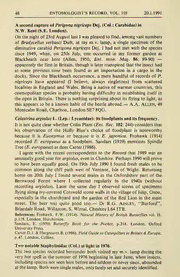
Celastrina argiolus L. (Lep.: Lycaenidae): its foodplants and its frequency PDF
Preview Celastrina argiolus L. (Lep.: Lycaenidae): its foodplants and its frequency
46 ENTOMOLOGIST'S RECORD, VOL. 103 20.1.1991 A second capture ofPerigonanigriceps Dej. (Col.: Carabidae) in N.W. Kent (S.E. London). On the night of23rd August last I was pleased to find, among vast numbers of Bradycellus verbasci Duft, at my m.v. lamp, a single specimen of the diminutive carabid Perigona nigriceps Dej. I had not met with the species since 1949, when, on 25th July, one occurred in my former garden at — Blackheath near here (Allen, 1950, Ent. mon. Mag. 86: 89-90) apparently the first in Britain, though it later transpired that the insect had at some previous time been found as an importation in a cargo in the docks. Since the Blackheath occurrence, a mere handful of records of P. nigriceps have appeared (I believe, always singletons) from scattered localities in England and Wales. Being a native of warmer countries, this cosmopolitan species is probably having difficulty in establishing itself in the open in Britain. There is nothing surprising about its flying to light, as — this appears to be a known habit of the beetle abroad. A.A. Allen, 49 Montcalm Road, Charlton, London SE7 8QG. Celastrinaargiolus L. (Lep.: Lycanidae): its foodplants and its frequency. It is not quite clear whether CoHn Plant {Ent. Rec. 102: 244) considers that his observation of the Holly Blue's choice of foodplant is noteworthy because it is Euonymus or because it is E. japonica. Frohawk (1914) recorded E. europaeus as a foodplant. Sandars (1939) mentions Spindle Tree {E. europaeus) as does Carter (1986). I agree with the recent correspondents to the Record that 1989 was an unusually good year for argiolus, even in Cheshire. Perhaps 1990will prove to have been equally good. On 19th July 1990 I found fresh males to be common along the cliff path west of Ventnor, Isle of Wight. Returning home on 20th July I found several males in the Oxfordshire part of the Bernwood Forest where I collected regularly in the 1940s (without recording argiolus). Later the same day I observed scores of specimens flying along ivy-covered Cotswold stone walls in the village of Islip, Oxon, especially in the churchyard and the garden of the Red Lion in the main — street. The beer was quite good too. Dr R.G. Ainley, "Burford", Briardale Road, Willaston, S. Wirral, Cheshire L64 1TB. References: Frohawk, F.W. (1914). Natural History ofBritish Butterflies vol. II, p.118. London, Hutchinson. Sandars, E. (1939) Butterfly Book for the Pocket, p.218. London, Oxford University Press. Carter D.J. &Hargreaves B. (1986). FieldGuideto CaterpillarsinBritain &Europe, p.47. London, Collins. Two notable Staphylinidae (Col.) at light in 1976. The two species recorded hereunder both visited my m.v. lamp during the very hot spell in the summer of 1976 beginning in late June, when insects, including species not seen here before and seldom or never since, abounded at the lamp. Both were single males, only lately set and securely identified.
